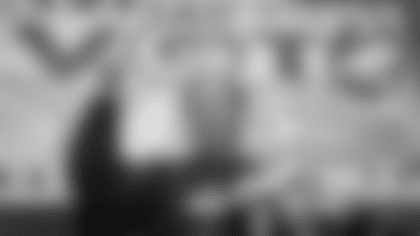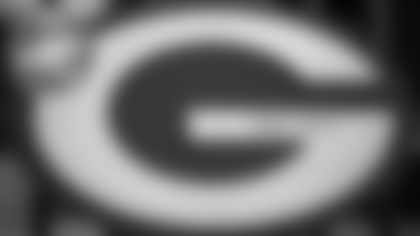Tom from Green Bay
I recently finished reading a book written by Larry D. Names. The title is, "The History of the Green Bay Packers: The Lambeau Years, Part One." The author tells about the early history of football in Green Bay and the beginning of the team now known as the Packers. In the first two chapters, he outlines the various teams that represented the city in the early days of "professional" football. The author arrives at Nate Abrams being the founder because he organized and captained the city team in 1918. Names further stated that Abrams was a major, behind-the-scenes moneyman who helped keep the team afloat in the early years. Why hasn't Abrams been given some credit for helping found the Packers given his key roles in their existence?
I believe the story of the Packers is the greatest in sports and started preaching the point even before becoming the team's historian a little more than four years ago. Unfortunately, far too many writers have failed in their responsibility to be good stewards of their own subject matter and our history.
I understand how parts of the story have gotten muddled.
- How many new ventures start seamlessly even today? If you were to start a pickup rec team in whatever sport or even a small business, would you be able to go back and recreate a timeline a year later or a decade later if you hadn't kept meticulous notes? That's basically what happened with the Packers. They had no grand plans. They were organized when almost every city of any size in the Midwest and beyond had at least one local football team and often several of them. There were few leagues, most teams lived week to week and they all played on sandlot fields in local parks with few if any people watching. That's how the Packers got started. Only months earlier, the organization of an industrial baseball league in Green Bay was covered in more detail by the Green Bay Press-Gazette.
- It didn't take long before the Press-Gazette started covering its team better than just about any newspaper in the country, but it had skipped over the details about how it was organized, what led up to the first meeting, who was there and what transpired. Thus, we know nothing about any of that. But that's part of what makes the Packers' story so compelling: Their unremarkable start and the intrigue of the unknown.
Anyway, the first book about Packers history was written in 1946 by Arch Ward, sports editor of the Chicago Tribune and one of the most powerful figures in the world of sports at the time. I still consider his book a classic and one that got most things right. But Ward, like other writers of his day who wrote about Packers history for newspapers and magazines, was at a distinct disadvantage because there were no microfilm copies of the Press-Gazette available to him. He and his contemporaries were almost totally dependent on people's memories of events, which took place 10, 20, 30 years earlier.
It wasn't until the mid 1950s that someone could research the Press-Gazette on microfilm and, from what I've been able to gather, it was another 15 years or so before they could do it electronically. And that was only at two or three sites in Wisconsin. Outside the state, I'm not aware of the early editions of the Press-Gazette being available anywhere until they recently appeared online.
Names published his first book in 1987. By then, someone could go through microfilm and follow the Press-Gazette's coverage of the Packers from 1919 forward. Not surprisingly, what was in the paper wasn't always in accord with the many word-of-mouth myths that had surfaced about early Packers history.
Names was the first, I believe, to pick up on that. Unfortunately, rather than doing additional research by pouring through NFL minutes, public records, archival material available at other libraries and historical societies, Names simply concocted his own version of Packers history based on unsubstantiated information, much of it gathered from questionable sources. Names had resided in seven states, attended 11 schools and written mostly fiction before that. Not surprisingly, his books on the Packers are littered with outlandish conspiracy theories that don't stand up to the truth test. Plus, he made an abundance of simple factual mistakes.
I think his theory on Abrams is one of them.
Granted, in the early 1930s, the first few Packers' publicity books included a short item about the team being organized in 1918. By all accounts, George Whitney Calhoun, co-founder of the Packers with Curly Lambeau and the team's publicity director over its first quarter-century, wrote those booklets. Obviously, anything Calhoun wrote or said can't be summarily dismissed. But that wasn't the only version of Packers history Calhoun served up. At other times during those years, he wrote 1919 was the start and then later he dropped all references to 1918. Additionally, Lambeau and some of the original players also traced the beginning of the Packers to 1919. Add it all up and there's far more convincing evidence the Packers were established in 1919 and not the year before.
Still, the vignette in the original publicity books – 1930, '31 and '33 was where I found it – begs the question: Why?
I don't know the answer. Calhoun was the manager in 1918 and maybe he decided to trace the start to the year he got involved. Maybe he thought that would ensure his place in history rather than having Lambeau get all the credit. But those are just wild guesses.
Whatever, by 1933, a record section was added to the booklet and it started with the 1919 season. And by 1935, the item about the Packers being organized in 1918 was removed for good.
There also was a clear distinction between the 1918 and 1919 teams in other ways.
The 1919 team was the first called the Packers, the first to be sponsored by the Indian Packing Co., and the first to be led by Lambeau. Also, more than half the players were new. The 1918 team either went by three different nicknames – Skidoos, Whales and Bays – or was organized and reorganized three different times with only 11 of 32 players returning in 1919.
In the second chapter of his book, Names wrote Abrams organized the Green Bay city team on Oct. 9, 1918, and it beat Appleton, 72-0, in its first game. Names also credited Abrams with being captain and sponsor.
But, again, it's hard to find much support for Names' storyline. On Sept. 15, a Green Bay team beat De Pere, 13-0. A week later, it beat Marinette, 42-0.
Also, the Press-Gazette made an early and brief reference to Abrams being captain, but then repeatedly referred to it as Art Schmaehl's team throughout the season. Schmaehl was a Coast Guard officer and arguably the team's best player that year. He also was the football coach at East High School.
Here's something else Names got wrong about Abrams. He said he grew up with Lambeau, but didn't attend high school. Not so. Abrams played at East High in 1915, Curly's junior year.
By no means do I want to discredit Abrams and his early contribution to the Packers. He stood 5 feet 4 inches, weighed 145 pounds and played in all 11 games for the original 1919 team. In 1920, he played again. He even played in one American Professional Football Association game – now the NFL – in 1921 and scored a touchdown on an interception.
It's also certainly possible Abrams might have pitched in and helped Lambeau put a team together in 1919. But that probably could be said about any of the original Packers.
Lastly, Abrams' involvement with the team didn't end with his playing days. In 1922, when the Packers found themselves without a sponsor, Abrams, Lambeau, Calhoun and Joe Ordens formed a private corporation, based on its Articles of Incorporation filed with the state, to keep the team alive. Abrams served as treasurer, based on a Certificate of Newly Elected Officers filed in the Brown County of Register of Deeds, and the corporation finished the season deep in debt. In fact, based on league minutes, the NFL moved quickly to seize the franchise from those four men, months before the community-owned corporation that saved the Packers was officially created. But that group bought Green Bay some time to get its finances in order.
All that said, to credit Abrams, not Lambeau, with starting the Packers a year before anyone called them by that name seems absolutely absurd.
Dan from Minneapolis
Can you outline the ownership of the Packers prior to their charter as a public team? Did Nate Abrams give $3,000 to Lambeau for ownership in 1922? This was from the Names' book. Any insight or confirmation?
First, here's the ownership timeline.
1919 – Indian Packing Co. sponsored the team.
1920 – Indian Packing sponsored the team again.
(Note: Names incorrectly wrote in his book that Indian sold out to Acme before the 1920 season. Not true. The announcement of the sale was made Dec. 22, 1920, more than three weeks after the season ended, and the consolidation wasn't finalized until early January 1921. There also are company letterheads that verify Indian Packing's involvement in 1920.)
1921 – First, Acme Packing Co., then the Clair Brothers stuck money into the team in its first year in what is now the NFL.
(Note: The APFA franchise was awarded to the Acme Packing on Aug. 27, 1921, according to league minutes. Acme, in turn, provided enough money to buy some equipment for the team and also uniforms, emblazoned with "Acme Packers" across the front. However, on Oct. 30, a little more than two months later and only one week after the Packers played their first league game, the team announced in its official publication, "The Dope Sheet," that it was cutting all ties to Acme Packing. By then, a representative of banks in New York and Chicago had come to Green Bay and taken over Acme Packing. The reason? It was $3.65 million in debt, or $50 million in today's money. At that point, the Clair brothers, J. Emmett and John, took control of the franchise. J. Emmett was the younger of the two and manager of the Packers; John had been an officer with Acme Packing. Together, they lost $3,800.
1922 – Green Bay Football Club
(Note: This was the private corporation headed by Lambeau, Calhoun, Abrams and Ordens. It was formed Sept. 14, 1922, and held title to the franchise until the NFL took it away on Jan. 20, 1923. Eight months later, the community-owned Green Bay Football Corporation was created and it lasted into the early 1930s.)
Abrams was a Jewish cattle buyer. Names said he sold cattle to the Indian Packing Co., and suggested he was well heeled. First, Abrams was only 20 years old in 1918. Second, there were pens for cattle at Indian Packing, but no cattle were ever slaughtered there or at the Acme plant.
So where did Abrams get $3,000, the equivalent of about $45,000 in today's money, to invest in a corporation that lasted four months?
Consider this: A year later, the Packers held a public stock sale where shares were sold for $5 and probably every large company and prominent citizen in Green Bay was approached, yet all they could raise was $5,545.
Abrams died in 1941 at age 43. There was a Depression between his playing days and his death, and people sometimes lose their fortunes over the course of a lifetime.
But according to Abrams' Petition for Probate of Will, on file at the Brown County Courthouse, the gross value of his estate was $15,392.58. Of that, his real estate, presumably his home, was worth $9,500 and his life insurance amounted to a little under $5,000. The rest, $1,158, was all Abrams had in cash and other personal property. He also had more than $8,000 in debts. In the end, his heirs shared $6,400.
This was Lambeau's moneyman? Let's get real.
I knew members of the family when I was growing up in Green Bay. Originally, three brothers migrated here to escape Russian rule in their homeland and each decided to adopt a different spelling: Abrams, Abrohams and Abrahams. Nate never married and didn't have any kids so his only living descendants are cousins.
Janice Abrohams, who believes she is a second cousin and also the niece of Eddie Glick, another of the early Packers, has nothing but fond memories of Nate. "He was a sweetheart," she said. "He was a little short guy with curly hair and he got cancer. He loved football."
But she said she never heard anything about Nate lending the Packers money. And when asked if Nate ever had much money, she said, "I don't think so."
Ben Abrohams, the son of one of Nate's first cousins, agreed and said he never heard anything, either, about Nate starting the Packers. "I never heard him mentioned other than in passing," he said. "Not even my dad talked about it." Peter from Green Bay
I heard your interview on the "Fifth Quarter" radio show in August and was surprised at your remarks about the Names books. My father, Elijah "Pete" Tinsley played guard for the Packers (1938-45) and thought they were much better than most books that were around at the time. While he wasn't in Green Bay until 1938, a lot of what my dad heard about the early years came from first-hand accounts of people who were there. Newspaper articles written in the early days by an editor that was involved with the team should be looked at with a questioning attitude.
I remember your dad when he coached high school football in Florence, Wis.
To your question, reading Names' books years ago was what got me intrigued about early Packers history. When Names debunked story after story from previous books and sources, I thought: Is all this really true? However, as a journalist, I also knew I couldn't use much of anything he wrote because it wasn't gained through exhaustive research or substantiated by credible sources. I knew Jim Ford, whom he acknowledged in the front of the book as a research assistant and primary source of information. So I started to research on my own the various topics Names addressed.
The first one I looked into was whether Lambeau was the first coach of the Packers and Names was right. Lambeau wasn't. But thereafter I found very little to authenticate his many suppositions. What I realized instead was that Names had simply concocted his own theories – conspiracy theories, for the most part – with little or no basis.
By the way, Peter, I agree with you. No way I could simply take Calhoun's word for all that he had written in the paper and for the Packers. I needed to apply the same standard here that I did as a newspaperman: Two primary and highly credible sources or one primary, irrefutable document. Often, it's harder to disprove something than prove it, but what I kept finding in Names' books was error after error.
I've pointed out several already. Here are some others.
According to Names: 1896 was the first year of semipro football in Green Bay and someone named Miller was the coach and captain; and, therefore, he should be credited with starting football in Green Bay.
The truth: Green Bay had a team in 1895 that played six games against outside competition and went 1-5. Fred Hulbert was the driving force behind it. In 1896, Hulbert was elected captain again after the first game, but was replaced 11 days later before the second game by O.W. Neeves. In the meantime, Joseph Miller, the team's quarterback, was named coach. Later, George Pratt replaced Neeves as captain. And, by the end of the season, former University of Wisconsin letterman Tom Silverwood had moved to Green Bay, taken over the team and turned what was a rag-tag outfit into a competitive one.
Names: Lambeau lived at 1205 Cherry St.
The truth: Based on U.S. census data, city directories, tax rolls, an enrollment card at East High and other sources, the Lambeaus never lived there or owned the property.
Names: As a senior, Lambeau won the shot, discus and hammer at the conference track meet.
The truth: East High wasn't in a conference when Lambeau went to school there and there's no evidence East had a track team his senior year. The track section in Lambeau's senior yearbook referenced his junior season, one of the rare years back then when East or West had a team.
Names: Lambeau enrolled at the University of Wisconsin in the fall of 1917, but dropped out less than a month later because the freshman football season was cancelled.
The truth: Based on university records, Lambeau never enrolled. He also never took his physical for football or checked out equipment. Nor was the freshman season cancelled. That's three strikes in one sentence.
Names: Lambeau was allowed to play at Notre Dame in 1918 because he had enrolled at UW and was considered a sophomore.
The truth: Lambeau was able to play as a freshman at Notre Dame in 1918 because of the war. Freshmen were granted eligibility for one year at most schools because there was a player shortage.
Names: The Rival Dog Food Co. of Chicago purchased Indian Packing in late 1918 and moved the company from Providence, R.I., to Green Bay. Frank Peck, in turn, was one of the management people who moved with Rival Dog Food.
The truth: In August 1916, the New England Supply Co. of Providence announced it was moving to Green Bay because of the scarcity of cattle in the East. New England Supply was the maker of nearly 100 brands of meat products. Three months later, Indian Packing was incorporated in Wisconsin, according to state records of corporate filings, essentially as an offshoot of two recently formed local companies, Green Bay Packing and Green Bay Stock Yards and Transit, as well as New England Supply. While it was a more complicated transaction than that and New England Supply continued to operate in Providence, Peck was named president of Indian Packing in March 1917, again, according to an annual report filed with the state at the time. Previously, he was president of New England Supply and eventually he moved from Providence to Green Bay. Peck was a graduate of Williams College in Massachusetts and the school has a bio of him in its archives with his corporate affiliations. There's no mention of Peck being affiliated with a dog food company.
Those were just some of the mistakes found in the first two chapters, covering less than 50 pages, of Names' first book on the Packers. And I could go on and on and on.
For example, I haven't even touched on Names' preposterous claims about the Packers getting kicked out of the league for playing ineligible players from Notre Dame against the Chicago Staleys (Bears) and then Halas writing stories for the sports columnist at the Tribune, beating the drums to throw the Packers out of the league. All it takes is reading official minutes in the University of Notre Dame Archives and the Pro Football Hall of Fame's research center, as well as the coverage in the Tribune and one of the Racine papers to realize what Names wrote was all poppycock.
We all make mistakes, but how many can someone make before losing all credibility? Sadly, countless writers and authors have extensively cited Names' work in the years since, repeating his fabrications and doing a disservice to our history.
But here's another truth: No fiction writer could craft a better story of Packers history than the real one.















